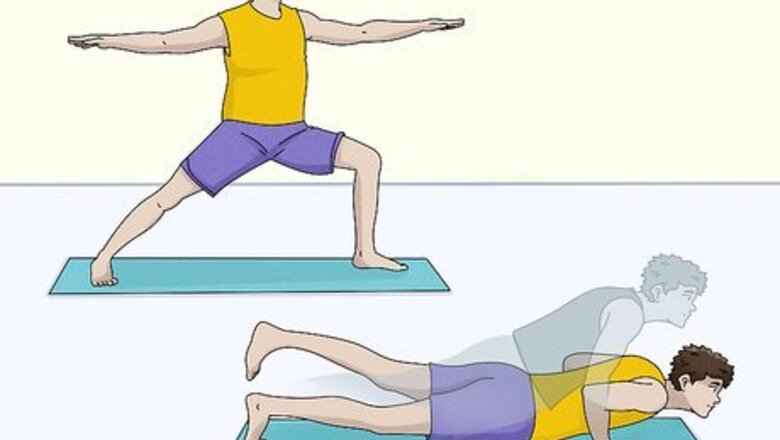
views
X
Research source
Linebackers are the attack dogs of the gridiron, called upon to provide defensive coverage for both running and passing plays. Because of their versatile role, excellent linebackers must be quick, tough, intelligent, and powerful. Read on for instructions to get you started on your path to linebacker excellence.
Improving your Technique
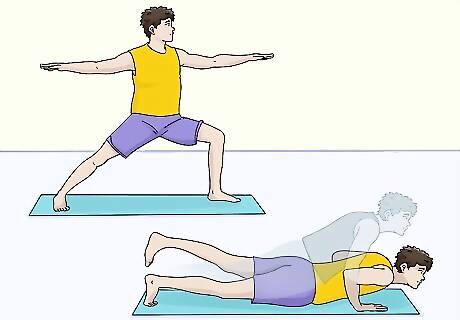
Start a vigorous exercise routine. Linebackers are expected to rush the quarterback, offer pass coverage, and stop runs. Linebackers must be fast enough to catch receivers yet strong enough to tackle a running back at full speed. A lean, powerful physicality is the core upon which a great linebacker's game is built. If you don't already have an exercise routine, begin one today. The faster you can run and the harder you can hit, the more effective you'll be as a linebacker. Because the linebacker needs to rapidly move from one defensive role to the next, a solid cardio routine is a must. Jog to build your endurance, but also make sure to run sprints to build the speed you'll need to take down the fastest running backs and receivers. Strength training is also essential. Linebackers need to be able to go toe-to-toe with immense linemen while rushing the quarterback. Powerful leg, back, and core muscles are highly prized - these muscle groups are the foundation for strong rushing and tackling ability. In addition, a linebacker needs quick, strong arms to fight past linemen and pull ball carriers down. Ray Lewis recommends a robust mix of bench presses, shrugs, squats, and bicep curls.
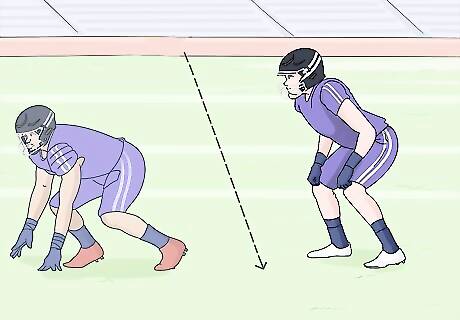
Know your stance. The linebacker's first few seconds of motion can make or break a defensive play. Having a good ready stance is necessary for quick, decisive action as soon as the ball is snapped. Linebackers use a two-point stance (two feet touching the ground) as opposed to the three or four-point stance used by linemen (two feet plus one or two hands touching the ground, respectively.) Linebackers play a highly mobile role - three and four-point stances are good for linemen who want to dig down and explode into other linemen, but not linebackers, who need to be ready to run. Keep a wide base. Your feet should be a little more than shoulder width apart, with your toes pointed inwards. This wide, stable base will ensure you're well-balanced and prevent false steps. Bend your knees so that you can sit back into your stance. Make sure to bend at your waist, not at your back. Keep your chest big and pointed outward. You can rest your arms lightly on your thighs or let them hang loosely, but don't put your hands on your knees, as this encourages you to bend at the back and also takes longer to move out of when the ball is snapped.
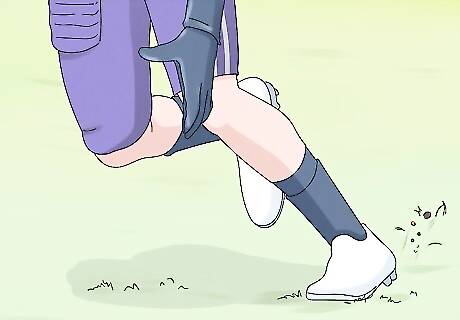
Practice your first step. A good linebacker is constantly reading the offense, but a good quarterback is constantly reading you. The first few moments of a play are critical. If you hesitate on your first step or telegraph your intended direction too early, then an intelligent offense will be able to exploit your mistake. Be sure to practice the first, critical step you take out of your stance. Your first step should be no more than six inches. Make it in the direction the ball is traveling. Use your first step as a foothold to push off of as you build speed for your play.
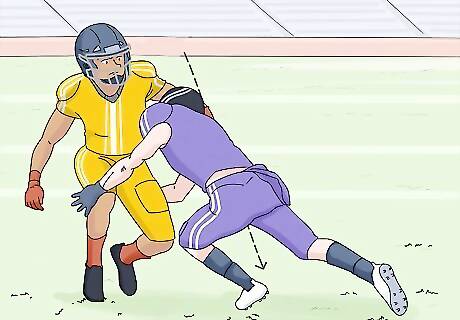
Practice correct tackling technique. Football players shouldn't set foot on the gridiron without understanding how to safely tackle. Bad form when tackling can lead to concussions or crippling spinal injuries. Don't put yourself (or the ball carrier) at risk - know what you're doing. Tackling can be broken down into three stages: approach, contact, and finish. Each had its own technique to safely maximize your chances of putting the ball carrier on his back. Approach: Keep a wide stance, keep your head up, and keep your eyes open. Keep on your feet as you begin your tackle. Contact: As you make contact with the ball carrier at his hips or below, thrust your arms up and around him. Grab the cloth of his jersey. Pull the ball carrier toward you as you use the power of your legs and core to bring him down. Finish: Keep your feet moving and keep your center of balance low. "Run through" the ball carrier as you continue to pull him down.
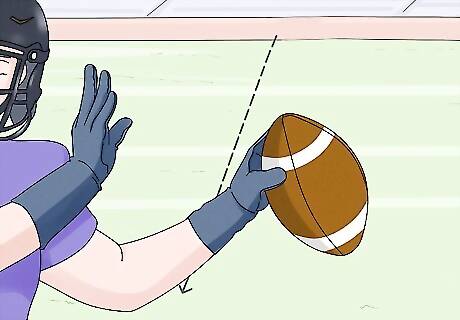
Practice your pass coverage. Linebackers aren't just tackling machines - they're frequently called upon to cover receivers. Line up against a quarterback and a receiver, then practice intercepting and swatting down short passes. When the ball's snapped, keep low and shuffle backwards, keeping your shoulders forward and watching the quarterback and receiver. When the receiver passes you, follow him, keeping your body between him and the ball. Stay inside and under the receiver - be a yard or two upfield from him, between the quarterback and him.
Mastering Defensive Skills

Practice linebacker-specific drills. By practicing certain fundamental movements and strategies, a linebacker can begin internalizing his skills. Eventually, a successful linebacker's fundamentals will be committed to muscle memory and he'll be able to position himself to react to offensive threats with maximum speed and efficiency. If you're working with a coach, they will should be able to lead you through a variety of drills to maximize your linebacker potential. Below are just a few great drills for aspiring linebackers.
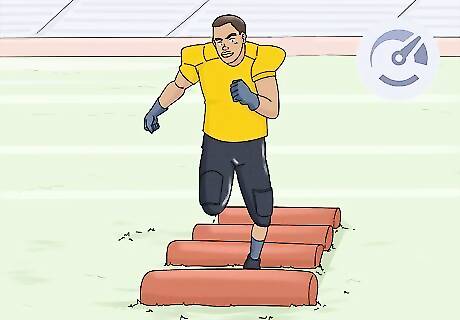
Improve your reaction speed. This drill improves your reaction speed and allows you to work on your critical first step. Get in your two point stance, and have a friend or coach stand in front of you with the ball. When the drill begins, the coach will move the ball to the left and right at irregular intervals. When the coach moves the ball, make your first six inch step in the direction of the ball's motion as quickly as you can, then return to your stance. Your coach shouldn't follow a pattern - keep things unpredictable.
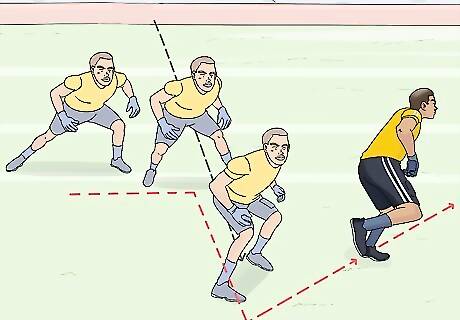
Learn to shuffle, read, and run. These drills improve your ability to recognize and stop a running play. Line up about 5 yards (4.6 m) away from a friend who's a quick runner, facing him while he faces you. Get in your stance. Your friend simulates receiving the ball from a hike, then starts to move to one side (chosen by him at random. Follow him laterally without closing ground on him too quickly. When he's moving slowly, stay in your stance and use a low, shuffling motion to advance on him at a 45 degree angle. Keep your shoulders pointed forward. When he moves quickly, sprint towards the sideline. Always stay about one step behind the runner - you don't want him to cut inside you. Try to force him towards the sideline.
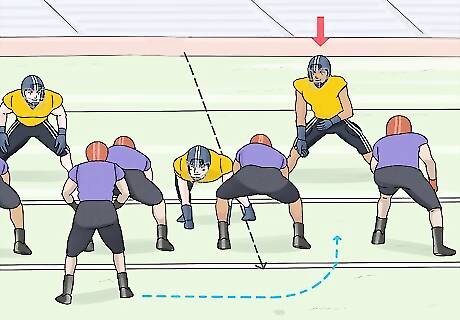
Learn to fill holes for running plays. Similar to above. You'll need another linebacker to practice with you. Useful for practicing plays where you're required to rush the quarterback or stop inside runs. Line up in your stance across from five evenly-spaced drums which will represent the offensive line (each linebacker should be lined up on either side of the middle bag/drum.) The coach will stand behind these and simulate receiving the ball from the snap. He'll then indicate motion to either side with the ball. If the ball moves right, the linebacker on the right will shuffle forward to the right, outside of the offensive line, while the linebacker on the right will fill the hole to the directly to the right of the central bag/drum. When the ball moves left, mirror the motions.
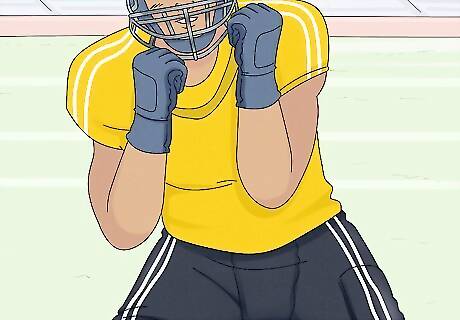
Keep your hands fast. An offensive lineman's job is to keep you from reaching the quarterback or ball carrier. To do this, they'll grab you, push you, and otherwise manhandle you. Get good at swatting their hands out of the way - if they can't shove or grab you, you'll stand a better chance of getting around them. Stand arm's length from a friend. Keep your hands up in front of your chest with your elbows in - like a boxer who's got his guard up. Have your friend try to grab your chest again and again, gradually increasing his speed. Practice swatting, blocking, or smacking his hands out of the way. Remember that if you miss his hand with one of your swats, you can try to break his grip with a "backhand" motion when you bring your arm back to its "ready" position.
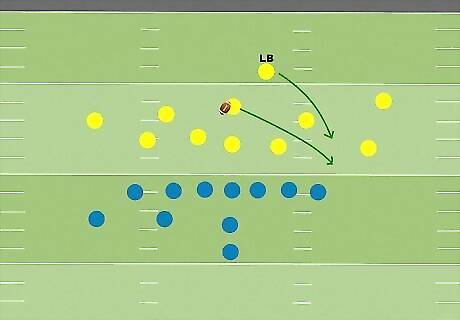
Stay home. Almost every coach will tell you this. If the coach called a play where you're lined up on the right side of the ball and you see the ball move left, don't cut and run left. Several offensive plays revolve around tricking defensive players into opening up "holes" for the offense. If you abandon your post, a quick running back will be able to exploit the hole you've left open for serious yards. When the ball crosses the line of scrimmage (or is about to), you can pursue it directly. Three plays that can give the other team a touchdown if you don't stay home: The counter, boot, and reverse. These three plays all involve a fake to one side followed by a "real" run to the other.
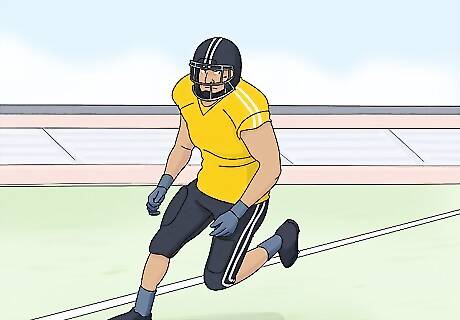
Spend plenty of time on the field. The best way to get good at something is simply to start doing it. Athleticism and well-practiced fundamentals aren't useful unless they can be applied to actual in-game situations. If you're already on a team, your coaches should organize scrimmages as an important part of your practice schedule. If not, play football with your friends at the park. If you don't have enough people to play a full 11-on-11 game, don't fret - you can hone your skills through "mini-scrimmages." Simply shrink your teams to incorporate as many people as you have. You might try pairing with one defensive lineman and one safety to take on an offense consisting of one quarterback, one lineman, and one receiver, for instance. Often, practice games aren't played at "full-speed." That is, certain safety measures are taken to ensure no one sustains an injury. For examples, tackles might be made with less force or not at all. Remember that even linebacker Lawrence Taylor, considered one of the best linebackers of all time, occasionally had miss games because of injuries.
Using Strategies for Defensive Leadership
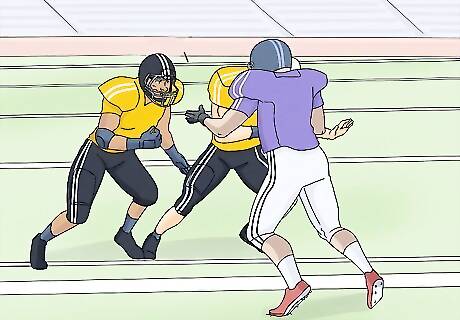
Be the on-the-field decision maker. Linebacker is one of the most important defensive positions, if not the most important. Generally, middle linebackers (sometimes called the "quarterbacks of the defense") receive calls from the defensive coach and give play calls to the defense on the field. Always "read" the offense so that you can make on-the-field changes to the defense. With intelligent, nuanced play-calling, your defense will come to respect and trust you.
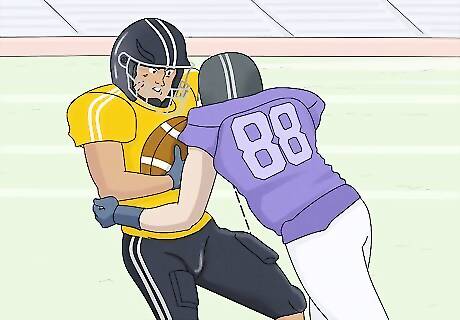
Lead by example - be the emotional core of the defense as well as its star player. Be the player all the other defensive players want to be. Show up to every practice early. Spend extra time in the weight room. Stay focused and positive. Your team mates will notice. Keep morale high. Keep your defense focused and "pumped up." This is easy at the beginning of the game, but hard when fatigue sets in. Even when you're frustrated by your players, it's generally better to build your defense up than tear it down - there's plenty of time for criticism in the locker room. Study. Know the defensive playbook inside and out, but also study offensive plays. Watch films of old games with a coach or mentor. Talk with your coaches about writing new plays. The better you understand football's overarching strategy, the better you'll be able to lead your defense to victory.
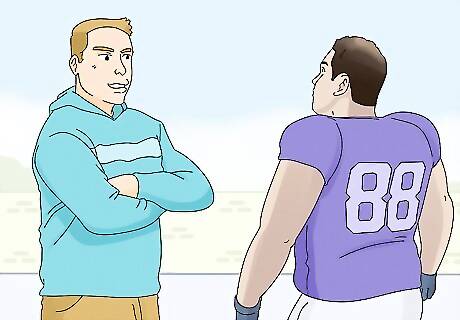
Listen carefully to the coach. As the defensive leader, you'll be responsible for relaying the coach's instructions to the defense on the field. Repeat what he says three or four times in your head. Know every play so that you don't have to ask questions or fill in the gaps in your knowledge with improvisation. Be confident in your play calling, and if you see the offense line up in a way that makes you think your defense won't be effective, call an audible on the field that logically counters the new offensive threat. One example of a defensive audible: The defense has lined up in a 3-4 formation (three defensive linemen, four linebackers) in preparation for a blitz with both outside linebackers. The offense lines up in "trips" formation (three receivers on one side of the field.) The defense might decide on the spot to change the blitz so that one of the middle linebackers and the weak side linebacker (the linebacker lined up on the opposite side as the three receivers) blitz, while the other two linebackers perform pass coverage. This preserves the pressure of the blitz while devoting the strong side linebacker to keeping pressure on the receivers. If you end up playing iron man football (playing both offense and defense) and you have taken a few hard hits, you may reach a point where your memory is nearly shot. Muscle memory and becomes important at this point.

Be rugged, but sportsmanlike. Your team counts on you to play your best and to hit as hard as possible. However, keep your sportsmanlike composure. Because of the rough, even violent nature of the position, defensive players sometimes psych themselves up by "getting angry." They work up feelings of rage so that they can more doggedly pursue and hit the ball carrier. You can manipulate your own emotions for better results, but do so only to a point. Never lose your composure, even if offensive players aggravate you with their words or behavior. Remember - if you abuse an offensive player or hit him illegally, you can win your team a personal foul (15 yards and an automatic first down for the offense) and even be ejected from the game. You'll also be setting a terrible example for other defensive players, who may look to you for guidance.
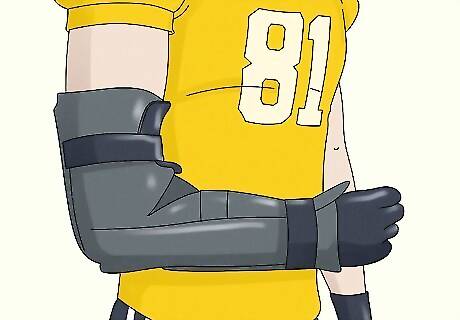
Take care of yourself. A linebacker has to be tough as nails, but when he's hurt, he should seek the help he need. Talk to your team's sports medicine professional if you feel any unusual aches or pains. S/he can recommend a regimen of treatments or exercise to get you back in fighting shape. Here are some things you might be required to do: Ice sore spots and/or injuries Wear a cast, sling, or other protective gear Use crutches to keep pressure off of an injured foot or leg Receive tissue massages Start a special stretch or exercise program See a doctor for more drastic treatment options


















Comments
0 comment